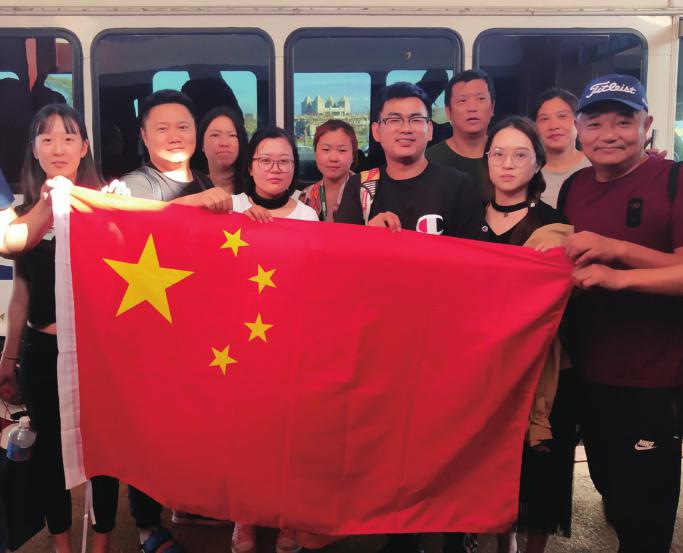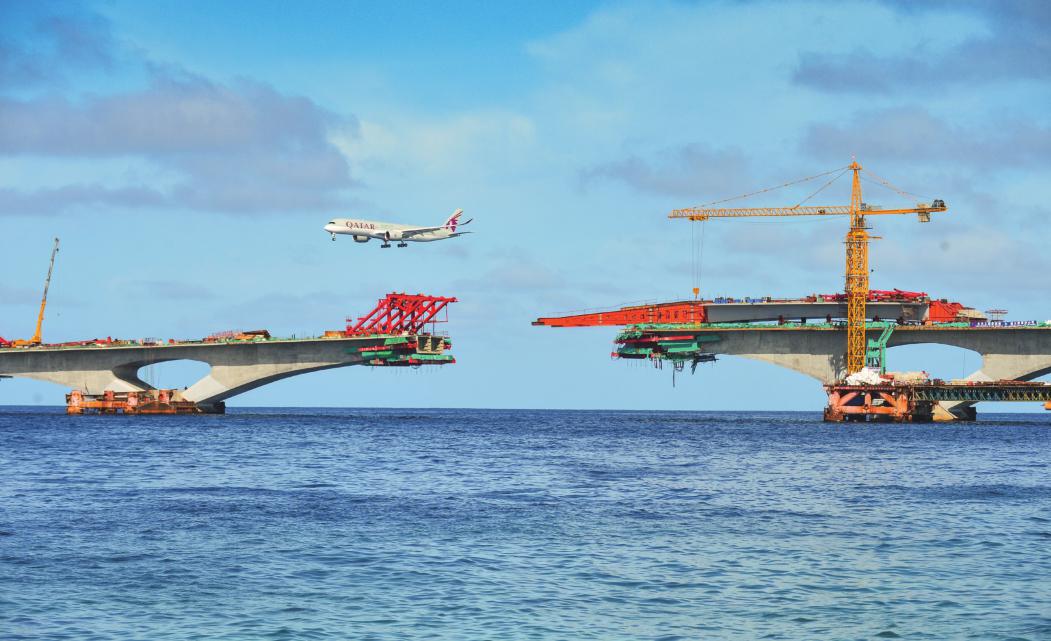CHALLENGING TIMES,CREATIVE EFFORTS
2018-02-17ByWangHuiyao
By Wang Huiyao

As the curtain comes down on 2018, it is a good moment to look back at the highlights and central themes of Chinas diplomacy during another eventful year.
For China, 2018 has been a year to continue building a new type of international relations based on three core tenets—mutual respect, fairness and justice, as well as win-win cooperation, with the long-term vision of building a community with a shared future for humanity.
This 21st-century world is shaped by increasing multipolarity and cross-border flows of people, goods, capital and information. It is a world of greater openness, where the cast of characters is more populous, complex and interconnected than ever before. It is also a world where technological progress and globalization are blurring boundaries and overturning traditional assumptions. The rise of emerging markets and developing countries is reconfi guring balances of power, while the international order of the last half-century increasingly struggles to accommodate to the new reality.
Against this evolving backdrop, the rest of the world is learning and adapting to the growing stage presence of China and other emerging powers. China is also defi ning its role in the world and refining how it interacts with fellow nations.
In this role, China will forge its own approach to international relations. In 2018, China has continued to expand its diplomatic reper-toire, leveraging conventional channels but also developing new mechanisms to build mutual understanding.
Throughout the year, Chinas diplomatic toolkit highlighted six key themes which start with the central role of summit diplomacy and include Sino-U.S. relations, breakthroughs with neighboring countries, cooperation along the Belt and Road, protecting growing overseas interests, and finally, efforts to reform and innovate the global governance system.
Summit diplomacy
Summit diplomacy has been the core pillar of Chinas international engagement in recent years. President Xi Jinping has been more active in global affairs than any previous Chinese leader and 2018 saw top-level summitry become more important than ever.
The role of summit diplomacy was evident at the recent G20 Buenos Aires Summit. As well as exploring joint solutions to global challenges, this gathering became an important chance to prevent the Sino-U.S. trade dispute from spiraling out of control. To the worlds relief, Xi and U.S. President Donald Trump were able to reach a preliminary “ceasefire” agreement to start working to resolve differences over economic relations.
While supporting existing mechanisms such as the G20, China has also led the creation and strengthening of new platforms to promote free trade and international cooperation. In 2018, China hosted four such international events: the Boao Forum for Asia Annual Conference, the Shanghai Cooperation Organization(SCO) Summit, the Forum on China-Africa Cooperation (FOCAC) Summit and the China International Import Expo (CIIE).
At the Boao Forum event in April, Xi sent a clear signal: China will continue to open up its economy and promote globalization with pledges to expand market access and improve the business environment for foreign investors. He also pledged to promote import growth. This gave firm support to globalization amid the protectionist wave that has swept the world.
This theme was reinforced at the inaugural CIIE in November. Much more than a trade fair, the CIIE served as a landmark in the evolution of Chinas development and its economic interaction with the rest of the world. Once renowned as the “factory of the world” for its role as an export powerhouse, today it is Chinas consumer market and imports that serve as an engine for global growth. As Xi said in his opening speech, over the next 15 years, China is set to import$30 trillion worth of goods and $10 trillion in services.
In June, the coastal city of Qingdao played host to the 2018 SCO Summit. Formed 17 years ago with regional security objectives in mind, the agenda of the SCO has broadened to include other areas of cooperation such as the economy and the environment. This years summit was significant as India and Pakistan attended in as new full members. The eightmember SCO now accounts for nearly half of the worlds population and over a fifth of the global GDP.
These events reflect Chinas efforts to build platforms and engage a broad range of partners across the world.
Sino-U.S. relations
China and the U.S. are the worlds most significant economic and political actors. In 2018, the twists and turns in their relations have formed the central storyline, not just of Chinas external relations, but of global affairs at large. As the trade dispute intensified, the goal of stabilizing the relations with the U.S. has been a key objective for Chinese diplomacy.
The meeting between the two presidents following the G20 Summit averted further escalation of tariffs and brought both sides back to the negotiating table. But despite this reprieve, it is clear that a fundamental shift has occurred in the relationship. A bipartisan view of China as an antagonist and biggest strategic competitor has coalesced in Washington. The U.S. approach of engagement in previous years is gradually being replaced by a mindset of containment.
In this regard, it was encouraging that the second annual U.S.-China Diplomatic and Security Dialogue was held in Beijing in November. This gave top diplomats and military officials from both sides a chance to talk and share perspectives of contentious issues.
Despite frictions, the two countries still have enormous potential synergies to exploit through closer cooperation, particularly with respect to transnational challenges such as climate change. Chinas participation in Californias Global Climate Action Summit in September showed that there are many channels for the two to work together. Deepening cooperation at the local level may offer an effective way to do this.
Breakthroughs with neighbors
Efforts to strengthen relations in the region to create a benign environment for the growth of economic and cultural links within Asia have contributed to breakthroughs with three fellow nations over the year.
First, 2018 saw a notable warming of ties between China and Japan. The premiers of both countries made reciprocal visits. Premier Li Keqiangs visit to Japan in May was followed by Japanese Prime Minister Shinzo Abes visit to Beijing in October, the first stand-alone journey to China by a Japanese leader in nearly seven years. During this visit, the premiers of Asias two biggest economies reached a series of agreements to deepen economic and trade ties.
Sino-Indian relations also experienced a positive turnaround following a period of heightened tensions caused by their border friction last year. Indian Prime Minister Narendra Modi visited China in April, holding talks with Xi to build mutual trust and deepen cooperation. China and India, the worlds two most populous nations, share strong cultural ties and economic complementarities. It is encouraging to see that Sino-Indian relations are now on a track to closer collaboration.
Third, with Chinas support, there has also been progress on the Korean Peninsula nuclear issue. This has seen the Democratic Peoples Republic of Korea hold breakthrough summits with China, the U.S. and the Republic of Korea. These are initial but important steps toward defusing tension on the peninsula and opening a channel for lasting peace in the region.
Belt and Road cooperation
In the five years since its launch, the Belt and Road Initiative, drawing on Chinas capital resources and infrastructure development capabilities, offers a new model of diplomacy by helping partner countries to improve connectivity and open new paths to growth and prosperity.
The initiative has been supported by growing numbers of Chinese enterprises that are going global. According to the Chinese Ministry of Commerce, in the first half of 2018, investment in 55 countries along the Belt and Road was up 12 percent year on year.
Alongside, China has directed diplomatic efforts to promote the initiative. Following the inaugural Belt and Road Forum for International Cooperation last year, as of 2018, more than 100 countries and regions as well as international organizations have signed cooperation agreements with China, extending the initiatives scope from Eurasia to Africa, Latin America and the Caribbean, and the South Pacific region.
The FOCAC Summit held in Beijing in September brought together leaders from China and African countries to explore new forms of collaboration. Xi announced $60 billion of financing for Africa in the form of government assistance as well as from financial institutions and companies. The summit built on Xis trip to Senegal, Rwanda, South Africa and Mauritius earlier in the year, the fourth African trip during his presidency.
Countries that previously held misgivings about the initiative such as Japan and the U.S. are gradually beginning to warm to it. During Abes visit to Beijing, China and Japan launched a mechanism to discuss economic cooperation projects in third countries related to the initiative. The number of foreign companies and financial institutions taking part in Belt and Road projects is increasing, helping to strengthen links between China and its partners around the world by sharing experience and mutual benefits.
Protecting overseas interests
Driven by Chinas opening up and the Belt and Road Initiative, the number of Chinese citizens and companies overseas is growing. According to the National Bureau of Statistics, China has been the country with the most outbound tour-ists in annual terms since 2013. The number of outbound tourists is expected to grow to 157 million in 2020, compared to 135 million in 2016.
Chinas accumulated outbound direct investment (ODI) reached over $1.8 trillion by the end of 2017, moving up to the second place in the world ranking. Chinese investment in both Europe and Africa saw an over 70-percent increase, while investment in countries along the Belt and Road accounted for over 12 percent of ODI, up 31.5 percent year on year.
These trends mean protecting the interests of Chinese citizens working, traveling and studying overseas has become an increasingly important task for Chinese diplomatic and consular services. The evolving risk map includes security threats and natural dangers. In 2017, the Chinese Foreign Ministry handled over 70,000 cases of consular protection. This year, Chinese nationals have been supported in a range of situations, from evacuating them from natural disasters to protecting them from terrorist threats.

To support this vital aspect of Chinas overseas work, in 2018 the Ministry of Foreign Affairs released draft legislation on consular protection to help safeguard Chinese citizens overseas.
Global governance reform
Recent years have seen multilateralism under increasing strain. There has been a rise in antiglobalization sentiment around the world, and countries that helped to build the international order are now undermining the very institutions that support it.
In part, the current global governance deficit is a result of multilateral institutions failing to reform and adapt to new challenges. Therefore, as well as supporting existing mechanisms, part of Chinas new role is to promote reform of the global governance system according to concepts of fairness and justice.
It is not only official agencies that are engaged in this task. A growing cast of social actors is also contributing ideas and impetus to reform global governance. This includes non- governmental think tanks that can help to generate and disseminate ideas at home and abroad. Many of the challenges require fresh approaches and cross-border collaboration between different types of organizations. Think tanks are well placed to support China in building a new type of international relations.
Through the ages, many have seen relations between actors on the stage of world history as antagonistic, driven by fear and selfinterest. Proponents of this view often see modern states as playing out predetermined roles, destined to clash and come into conflict as balances of power shift.
To build a new type of international relations, China has determined to craft its own role as the supporter of a more open, fairer world. It is likely that 2019 will bring more twists and turns in world affairs. However, it is hoped that the coming year will also provide more chances to build relationships, work together, and script a shared future for humanity.
